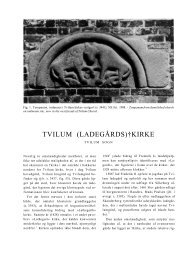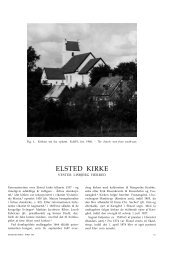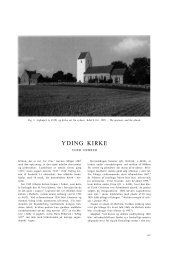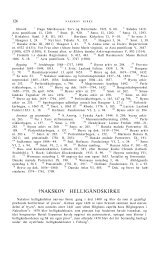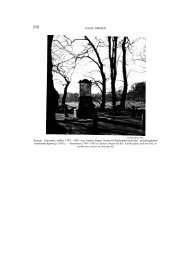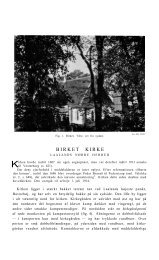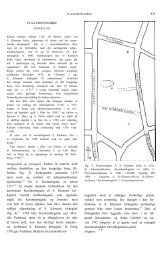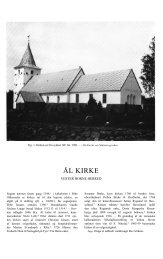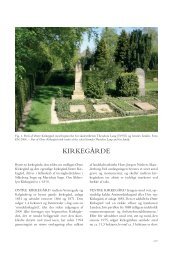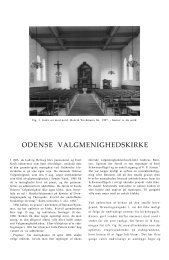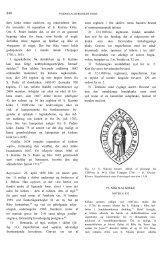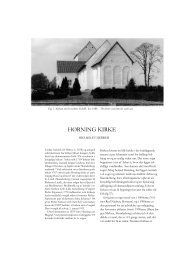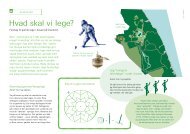Create successful ePaper yourself
Turn your PDF publications into a flip-book with our unique Google optimized e-Paper software.
middle of this we see small traces of the Last Supper,<br />
then what appears to be the Washing of the<br />
Feet and the Agony in the Garden (fig. 57). The<br />
pictures are slightly better preserved in the north<br />
(cf. fig. 58ff.). Here, between the two westernmost<br />
windows, there is a crossbearing scene where Simon<br />
of Cyrene seems to be carrying the small<br />
cross in front, after an Ottonian model, while Jesus<br />
is led forth by Jews with characteristic curly<br />
hair and Jewish hats (figs. 5960). This scene is followed<br />
in the middle of the north wall by a Crucifixion<br />
scene (figs. 6162), showing small men<br />
hammering on the Cross, and at the same time<br />
Longinus with the lance and a figure who must<br />
be Stephaton. Farther to the east one glimpses<br />
traces of the Deposition and farthest east the Entombment.<br />
Here one notes in particular a rich<br />
architectural border which again recalls Ottonian<br />
art, as well as what appears to be Jesus lying at<br />
the bottom swathed in crossed linen bands (figs.<br />
6364). Finally, we now see only a fragment of architecture<br />
northernmost on the east wall where<br />
the frieze must have culminated above the chancel<br />
arch. Here there was apparently room for two<br />
scenes flanking the present arcade opening (fig.<br />
56), which may have contained the focus of the<br />
painted frieze in the form of some sort of sculpture<br />
(the Ascension?). Finally it should be mentioned<br />
that in 2002 a †fragment was found on the<br />
north wall of the chancel (fig. 52) probably representing<br />
the birth of St. John the Baptist (to be<br />
compared with a corresponding scene in Jelling).<br />
The fragment will probably be covered again.<br />
The technique of the paintings must be designated<br />
al secco, since the yellowish and rather<br />
uneven grounding has had time to dry before<br />
the actual painting work was done. This began<br />
with a preliminary outlining and pointingup of<br />
contours. Identifiable colours are dark and light<br />
ochre, yellow, white, green and minium red. In<br />
the chancel arch one can make out a green background<br />
colour, and on the nave walls the background<br />
consists of whitewash. The decorations<br />
are by the same workshop as the murals in †Jelling,<br />
Ørridslev, Vrigsted and perhaps the older<br />
St. Nikolaj Cathedral in Århus. Stylistically the<br />
representations derive from Ottonian, especially<br />
<strong>TAMDRUP</strong> CHURCH<br />
5173<br />
Late Ottonian art of the kind that can be seen in<br />
Cologne illuminations from the second half of the<br />
eleventh century, and which is known from contemporary<br />
†murals in Xanten and Hildesheim.<br />
The Jutland painting’s oddly ‘bundled’ drapery<br />
might further indicate knowledge of the goldsmith<br />
Roger von Helmarshausen’s works from<br />
the time around 1100, which would accord excellently<br />
with the dendrochronological dating of<br />
Tamdrup Church to c. 1125.<br />
2) The later murals, from 1500-20, are only preserved<br />
in the chancel. The vaulting here has a series<br />
of representations of the story of Adam and<br />
Eve. From the northern cell’s Admonition of Adam<br />
and Eve, only God the Father is preserved<br />
(fig. 66). In the east one can make out the Tree of<br />
Knowledge and traces of the Fall; the south cell<br />
has a well preserved picture of the Expulsion (fig.<br />
67), and in the west cell a toiling Eve is preserved<br />
(fig. 65). Finally, high on the east wall, covered<br />
by the altarpiece, are the remains of a St. Peter<br />
and the arms of Bishop Niels Clausen Skade<br />
(14901520). The decoration, which exhibits dependence<br />
on the paintings in Århus Cathedral,<br />
can be attributed to the socalled Åle workshop,<br />
which was also active in the nearby churches in<br />
Åle, Skanderup, Østbirk and perhaps Stilling.<br />
*(†)GOLDEN ALTAR. The golden altar of the<br />
church, from c. 1200, is only partially preserved,<br />
but would have corresponded to similar magnificent<br />
altars from other Jutland churches such<br />
as Lisbjerg, Odder, Sahl, Stadil and Kværn. The<br />
main parts preserved are the actual embossed and<br />
gilded copper panels, which are practically all severely<br />
trimmed as a result of secondary use as ornamentation<br />
on the pulpit in 16001625. After<br />
being identified there in 1870 the panels were<br />
sent in 1873 to the National Museum, where<br />
they were repaired in 189697.<br />
Of the total of 29 panels, a large quatrefoilformed<br />
one with Christ in Majesty and four<br />
smaller related panels with the symbols of the<br />
evangelists form the central section of a frontal<br />
or antependium. The other 17 panels, with subjects<br />
from the infancy and passion of Christ, measured<br />
at least 20.1×17.9 cm, and the frontal can be re




